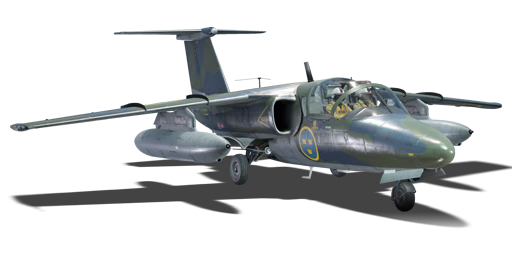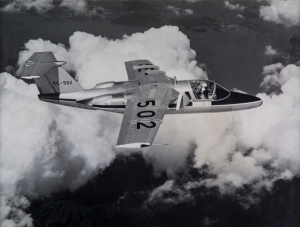SK60B
Contents
Description
The SK60B is a rank V Swedish jet attacker with a battle rating of 7.3 (AB/SB) and 7.0 (RB). It was introduced in Update "New Power".
General info
Flight performance
Describe how the aircraft behaves in the air. Speed, manoeuvrability, acceleration and allowable loads - these are the most important characteristics of the vehicle.
| Characteristics | Max Speed (km/h at _,___ m) |
Max altitude (metres) |
Turn time (seconds) |
Rate of climb (metres/second) |
Take-off run (metres) | |||
|---|---|---|---|---|---|---|---|---|
| AB | RB | AB | RB | AB | RB | |||
| Stock | ___ | ___ | 10668 | __._ | __._ | __._ | __._ | ___ |
| Upgraded | ___ | ___ | __._ | __._ | __._ | __._ | ||
Details
| Features | |||||
|---|---|---|---|---|---|
| Combat flaps | Take-off flaps | Landing flaps | Air brakes | Arrestor gear | Drogue chute |
| _ | _ | _ | _ | _ | _ |
| Limits | ||||||
|---|---|---|---|---|---|---|
| Wings (km/h) | Gear (km/h) | Flaps (km/h) | Max Static G | |||
| Combat | Take-off | Landing | + | - | ||
| 934 | 400 | ___ | ___ | ___ | ~__ | ~__ |
| Optimal velocities (km/h) | |||
|---|---|---|---|
| Ailerons | Rudder | Elevators | Radiator |
| < ___ | < ___ | < ___ | N/A |
Survivability and armour
Examine the survivability of the aircraft. Note how vulnerable the structure is and how secure the pilot is, whether the fuel tanks are armoured, etc. Describe the armour, if there is any, and also mention the vulnerability of other critical aircraft systems.
Armaments
Suspended armament
The SK60B can be outfitted with the following ordnance:
- 2 x 30 mm Akan m/55 cannons (150 rpg = 300 total)
- 2 x Rb05A missiles
- 6 x psrak m/49A rockets
- 12 x m/56D rockets
Usage in battles
Describe the tactics of playing in the aircraft, the features of using aircraft in a team and advice on tactics. Refrain from creating a "guide" - do not impose a single point of view, but instead, give the reader food for thought. Examine the most dangerous enemies and give recommendations on fighting them. If necessary, note the specifics of the game in different modes (AB, RB, SB).
Modules
| Tier | Flight performance | Survivability | Weaponry | ||
|---|---|---|---|---|---|
| I | |||||
| II | |||||
| III | |||||
| IV | |||||
Pros and cons
Summarise and briefly evaluate the vehicle in terms of its characteristics and combat effectiveness. Mark its pros and cons in the bulleted list. Try not to use more than 6 points for each of the characteristics. Avoid using categorical definitions such as "bad", "good" and the like - use substitutions with softer forms such as "inadequate" and "effective".
Pros:
Cons:
History
Background
Unlike most aircraft orders from the Swedish Air-Force, the Sk60 has an unusual background compared to its peers. The aircraft initially started as a commercial project under the name 220, led by none other than Eric Bratt, one of the main engineers behind the J35D. The aircraft was supposed to serve as a private airliner, sporting two engines, and a delta-wing design. But in the autumn of 1958, the Swedish Air-Force was looking for a successor to replace the aging Sk28C Vampire. This led Bratt and his team to rework the design of project 220, switching the delta-wing design for a conventional straight-wing one. When the Air-Force later specified that this trainer had to carry external ordinance in the form of gun pods, rockets, and bombs, the wing was moved to an upper position. A result of this radical change forced a complete reconstruction of the elevator, mounting it higher than before. Along with some tweaking of the cockpit design, the project received the official name Saab 105.
The first test flight was conducted in July of 1963, piloted by Karl-Erik Fernberg. The second prototype flew a year later, in June 1964. After some extensive modifying of the air-intakes and wing-structure, the plane was deemed worthy of production. However, during this period the design was going through extensive changes in terms of propulsion, as the french Turbomèca-Aubisque engines (RM9) lacked the required strength. This problem would delay the program another year, but would increase the overall engine thrust. The third prototype was deemed worthy of service by December of 1965. And by April 1966, the Sk60A would enter service with F5 Air-Division stationed at Ljungbyhed. Disappointingly, the french engines showed a lack of reliability and required a lot of modifying. This issue was however solved by SAAB during the second batch. The deliveries were finalized by 1968. Sk60B
The Sk60B was the second modification of the Saab 105. This version, just like the Sk60C, was directly modified from already existing Sk60A’s. The Sk60B featured a gunsight, along with the capability of carrying external ordinance in the form of bombs and rockets. The Sk60C went through identical modifications but featured an elongated nose-cone housing a panoramic camera for additional reconnaissance capabilities. Although the early Sk60 only sported a carrying capacity of around 700kg’s, the external ordinance allowed for diverse options depending on the mission, capable of dealing with lightly, and heavily armoured targets.
Light attack purposes
The Sk60B and Sk60C would see extensive use outside the primary training purpose, as on the 29th of May, 1972, the Swedish government decided a reorganization of the Air-Force's attacker divisions. This forced four attack divisions to be converted into four light-attack divisions, making use of the lightweight Sk60B and Sk60C. These would be stationed accordingly at F21, F5, F3, and F16 fighter wing. The Sk60 was light and slow compared to the Viggen platform. The plane operated inland, as the strike capacity wasn’t enough for naval operations, aside from small patrol boats and landing crafts. One major advantage of the Sk60 however, was the small profile and good aerodynamic properties, allowing for precise strike operations. This was already realized long before 1972, as F21 Luleå, an air division located alongside infantry and armoured divisions, saw potential in the Sk60 for close air support as early as 1969. This attacker mentality was put into action on all divisions between 1974 and 1976 and would see extensive use throughout the decade. Although the Sk60B was more of a last-ditch vehicle for air support, the plane proved lethal when put against armoured targets and helicopters, as it could remain fairly hidden by flying low against the ground. This strategy was necessary to avoid incoming fire, as the Sk60 featured no countermeasures or modern avionics. But as a result of the twin-seat design, low altitude flying became a lot safer. The pilot could focus entirely on flying as the second seat was occupied by a navigator giving directions. Though a lack of avionics was a major as the Sk60B required full eye-contact with the target to engage it. This limited the plane to only operate during clear weather, and along with a limited range, made the plane less ideal for wartime conditions.
Present day
The light attack divisions were already getting disbanded by the early 80s, and the light-attack educational program, along with the remaining light-attack divisions, were entirely disbanded by 1998. Although it’s easy to determine this as the end for the Sk60, the plane was still a fantastic trainer. The Sk60 went through a major engine overhaul in 1992, doubling its carrying capacity thanks to a much stronger engine. This fixed a lot of reliability issues, and thanks to modern avionics, the Sk60 featured ballistic computers and navigational systems. The Sk60 was projected to be withdrawn from service several times, but thanks to its reliability and flight performance, the Sk60 remains in active use with both the Swedish and Austrian air force, more than 55 years after its introduction. By some estimates, the Sk60 will remain in the Swedish Air-Force until 2030, making the Sk60 older than its numerical designation.
Devblog
In 1959, Saab began development of a new twin-engine jet aircraft, intended to serve a wide variety of different roles both in civilian and military use. This led to questions being raised regarding the powerplant choice for the new aircraft, causing delays in development. However, once the decision was made to develop the new aircraft solely for military purposes, the project substantially picked up in momentum.
By 1961, Saab’s efforts were endorsed by the Swedish Air Force, which sponsored the development of the aircraft, by then known as the Saab 105, and ordered the production of a prototype in trainer configuration for testing. The prototype took to the skies for its maiden flight in June 1963 and quickly demonstrated excellent handling characteristics. In 1964, the Swedish Air Force placed an initial order for 130 Saab 105’s, with that order being raised to 150 machines soon after. The machine received the designation Sk 60 in Swedish service.
During production, the Swedish Air Force drew conclusions from the experiences made by the U.S. forces during the Vietnam War and decided to convert the Saab 105 trainer into a light attack and reconnaissance aircraft. This undertaking proved to be successful, with 60 machines of the trainer version being converted for ground attack missions.
Apart from the Swedish Air Force, Austria also ordered a modified multirole version of the Saab 105 for its air force. Both air forces still employ the Saab 105 to the present day and around 190 units of the type were built in total.
Media
Excellent additions to the article would be video guides, screenshots from the game, and photos.
See also
Links to the articles on the War Thunder Wiki that you think will be useful for the reader, for example:
- reference to the series of the aircraft;
- links to approximate analogues of other nations and research trees.
External links
Paste links to sources and external resources, such as:
- topic on the official game forum;
- other literature.
| Sweden jet aircraft | |
|---|---|
| Fighters | J21RA |
| J29A · A29B · J29D · J29F | |
| J32B | |
| J34 | |
| J35A · J35D | |
| JA37C · JA37D | |
| JAS39A | |
| Strike aircraft | A21RB |
| A32A · A32A Röd Adam | |
| A28B | |
| AJ37 · AJS37 | |
| SK60B · SAAB-105G | |
| Export | SAAB-105OE |
| Finland | ▄Vampire FB 52A · ▄MiG-21bis · Saab J35XS |





